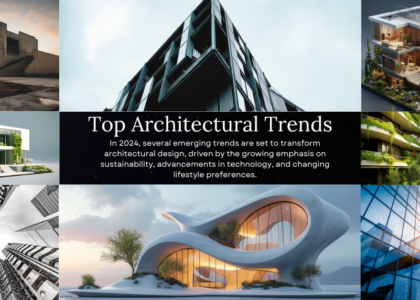The process of creating an architectural design is intricate and multidimensional, requiring a delicate balancing act between technical precision, creativity, and functionality. Even seasoned architects are prone to blunders that could seriously harm a project’s chances of success. This post will discuss five architectural mistakes made in architectural design and explain how to prevent these architectural mistakes to make sure your projects are effective, long-lasting, and visually beautiful.
Inadequate Site Analysis
Ignoring Environmental Factors
In architectural design, one of the most frequent errors is not performing a comprehensive site analysis. Uncomfortable and inefficient designs can result from ignoring environmental elements including the direction of the sun, wind patterns, and local climate. For instance, overlooking the strong afternoon sun when positioning wide windows on the western side might lead to overheating and increased energy expenses.
Overlooking Site Constraints
During the design stage, site constraints like topography, soil types, and existing plants must be taken into account. Ignoring these limitations might result in structural problems, higher building costs, and adverse environmental effects. Thorough site research facilitates the early detection of these issues and enables more informed design choices.
Poor Space Planning
Lack of Functionality
For structures to be both functional and efficient, space planning is essential. Not creating places to suit the demands of the occupants is a common mistake. Uncomfortable design, inadequate storage, and unused spaces can be the outcome of this. For example, putting the kitchen distant from the eating area can be inconvenient and decrease how useful the area is.
Ignoring Future Needs
Ignoring future needs is another facet of inadequate space planning. It is important to consider adaptability and flexibility while designing buildings. This entails preparing for shifts in occupancy, technology, and use. Buildings that are made to be easily expanded or modified throughout time are more likely to be useful and relevant.
Neglecting Sustainability
Inefficient Energy Use
Ignoring sustainability in this era of rising energy prices and climate change is a big mistake. Structures that are not energy-efficiently designed may have more ongoing expenses and a greater carbon impact. Typical errors include inadequate natural illumination, inefficient HVAC systems, and inadequate insulation. These problems can be lessened by implementing sustainable design concepts including renewable energy sources, energy-efficient appliances, and passive solar architecture.
Unsustainable Material Choices
The environmental performance of a structure can also be weakened by the use of non-sustainable materials. The use of high-emission, non-renewable materials can be detrimental to occupant health as well as the environment. Selecting eco-friendly materials such as bamboo, recycled steel, and low-VOC (volatile organic compound) coatings encourages occupant health and environmental responsibility.
Overcomplicated Design
Excessive Complexity
In architecture, original and creative ideas are highly prized, although too intricate designs can present practical difficulties. Excessive design complexity frequently leads to greater building costs, longer construction schedules, and more maintenance challenges. Retaining aesthetic appeal while simplifying design features can improve a project’s practicality and functionality. Stick to simple and reliable interior design.
Lack of Cohesion
The incoherence of design elements is a related error. A building that has too many different styles, materials, or colors may appear haphazard and visually cluttered. A united and aesthetically pleasing result is produced when all aspects function seamlessly together, which is ensured by aiming for a cohesive design approach.
Insufficient Communication and Collaboration
Poor Stakeholder Engagement
All parties involved in architectural design, including clients, building contractors, engineers, and consultants, must collaborate and communicate well for the project to be successful. Not including stakeholders early on and on a frequent basis during the design process is a common error. Misunderstandings, low expectations, and design changes may result from this. Collaboration is facilitated and everyone’s needs are met by the final design when clear communication channels are established and stakeholders are included in important decision-making processes.
Ignoring Feedback
Ignoring or disregarding stakeholders’ input may cause a project to suffer. Positive criticism can uncover potential problems that were overlooked and provide valuable insights. Incorporating feedback into the design process demonstrates a commitment to meeting customer needs and achieving the best results.
Conclusion
Preventing these architectural mistakes in architectural design necessitates a planned and proactive strategy. Successful construction projects require careful site evaluations, functional space planning as a top priority, integration of sustainability, simplification of designs, and promotion of efficient communication and teamwork. Architects may design structures that are not only inventive and beautiful, but also useful, sustainable, and sensitive to the requirements of their users by keeping these common mistakes in mind.




